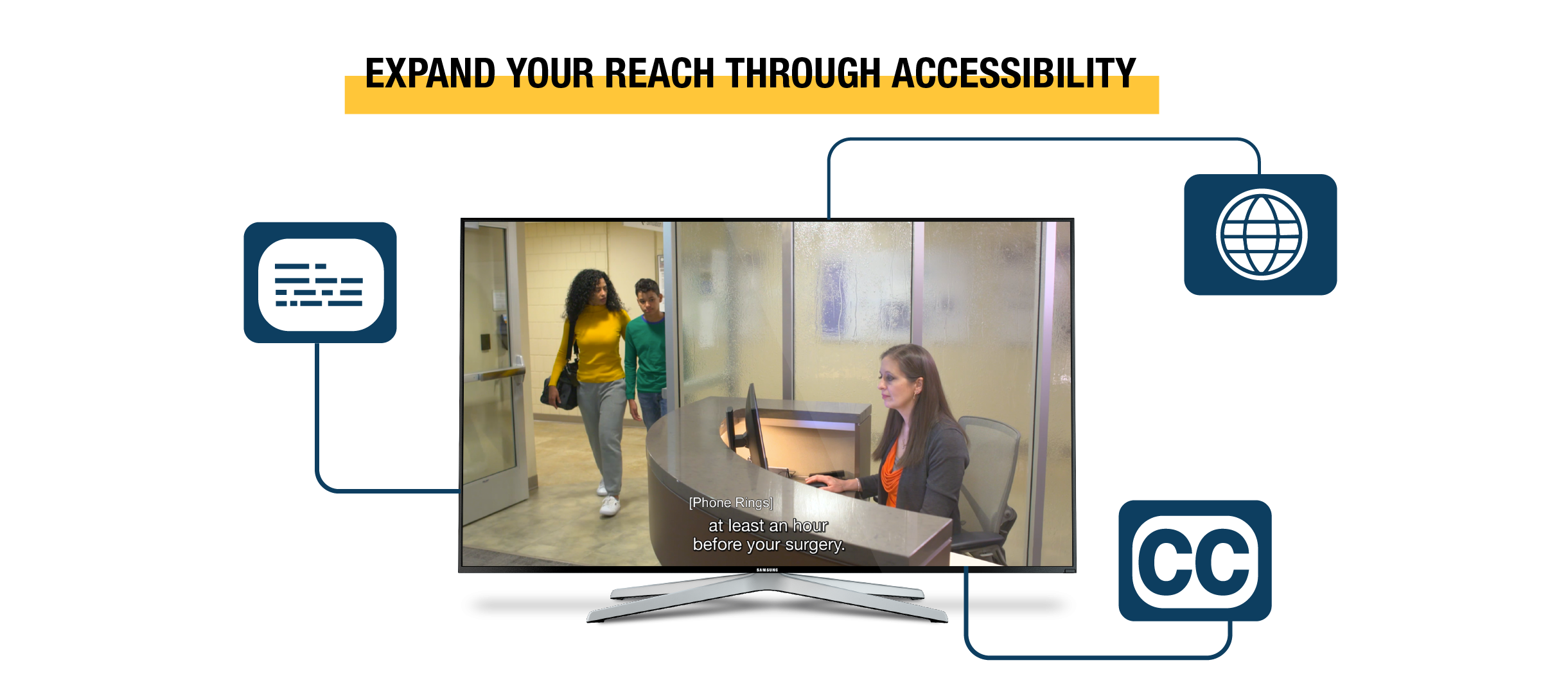What is Accessibility?
Accessible video content, in essence, is content that utilizes any number of communication aids to provide a comparable experience to a broader demographic. Accessible content is especially impactful for individuals who may have auditory, visual, or cognitive impairment. That being said, accessible content can still be very beneficial for audiences who may not be living with an impairment. For example, a viewer might benefit from captions if they are in a public setting where listening to audio would be inappropriate.
Incorporating accessibility features into your content will help you to engage with a wider audience, be more inclusive, and improve the overall viewer experience.
Strategies for Accessibility
So what are some strategies for making your content more accessible?
Open or Closed Captions
Captions are probably the most common accessible features. Captions can be separated into two categories, open and closed. Open captions are built into the video itself. Viewers are not given the option to disable open captions while watching. When sharing videos with closed captions, video authors upload an accompanying text document in addition to the video file. This allows viewers to turn closed captions on or off. While they both have advantages and disadvantages, they accomplish the same goal of providing viewers with a complete understanding of the video content.
Video Transcript
Video transcripts provide viewers with a detailed text version of the entire video, including; dialogue, sound effects descriptions, descriptions of visuals, pauses, etc. Video transcripts will typically include timestamps in the text, allowing for viewers to easily scan through the document to navigate to a desired section of the video. On video platforms like YouTube, video transcripts can be easily uploaded and accessed through the video page. Although not all platforms allow for transcripts to be linked to your video content, it is always good practice to make them available when possible.
Audio Descriptions
Audio descriptions essentially take video transcripts a step further by including additional narration describing visuals, throughout the video. This can be accomplished in a couple of different ways. Video authors can create alternative audio tracks in which they go through frame-by-frame or sequence-by-sequence to describe the on-screen visuals. Audio descriptions can also be created by leveraging video transcripts and voice-to-speech tools to provide users with time specific visual information.
Language Translations
Although typically not considered a component of accessible content, creating content to serve foriegn language speakers can greatly help to reach new audiences. Translation is the first step but localization is also important. Localization refers to the consideration of cultural, visual and technological aspects of users in different languages. Platforms like YouTube have built in tools to translate closed captions but taking translation a step further with audio can be a great way to be inclusive with your content.
Use of On-Screen Supporting Text
Using legible on-screen supporting text can help to make the user experience much more comprehensible and enjoyable. For some individuals, using smaller text, hard to read fonts, or certain text colors can make reading on-screen text much more difficult. Try to appeal to a broader audience by using appropriately sized, easy to read text.
Limit Overly Stimulating Visuals
Avoid overly stimulating uses of flashing lights in your videos when possible. Those visuals can be harmful to photosensitive or epileptic individuals. It is always good practice to provide a warning at the beginning of your video if you are going to be showing visuals that might negatively impact sensitive groups.
Benefits of Accessible Content
Reaches Wider Audiences
Accessible content can open up opportunities to reach audiences who may not otherwise be able to access your content normally; whether that is due to a disability, language barrier, or just by circumstance. By implementing accessibility features into your content, you are creating more ways that viewers can not only engage with your video content but also your website, business, and brand.
Improves User Experience
When you include accessible features in your content, you are giving audiences the option to view content in the way that works best for their situation. For some audience groups, a contemporary video watching experience might be very frustrating, difficult, and anxiety inducing. When you give your audiences an accessible outlet to engage with your content, you are fundamentally strengthening the relationship between you and your audience by creating a more positive viewing experience. It can help to create more opportunities for audience engagement, positively increase public opinion, and strengthen your client relationships and brand.
Improves Your SEO
A positive side effect of accessible video content is that it will help to boost your SEO. Including alternative text, transcripts, and translations can help search engines to better index information related to your video. All of the additional text data that make up a large portion of typical accessibility features are more easily recognized by search engines than just video and images. With no added effort, these features can help to create more impressions by expanding your contents overall reach.
It’s Time To Expand Your Reach
Making your content more accessible is one of best ways to get a better return on your video investment. At Meditech, accessibility is a major consideration for many of our clients. To find out more about how you can make your new and existing video content more accessible, reach out to us at accounts@gomeditech.com.

